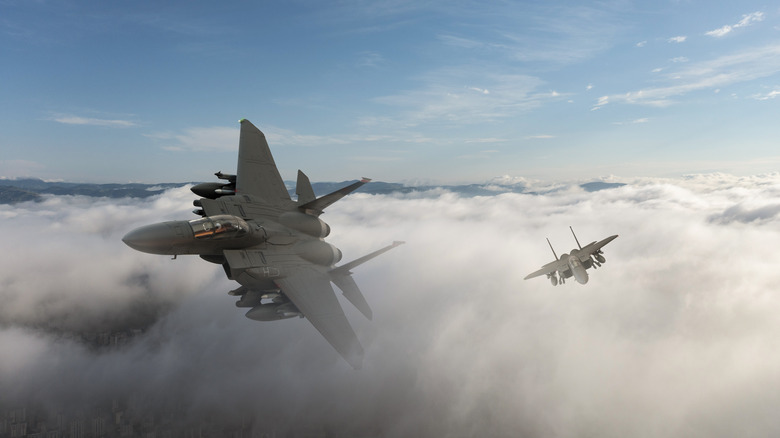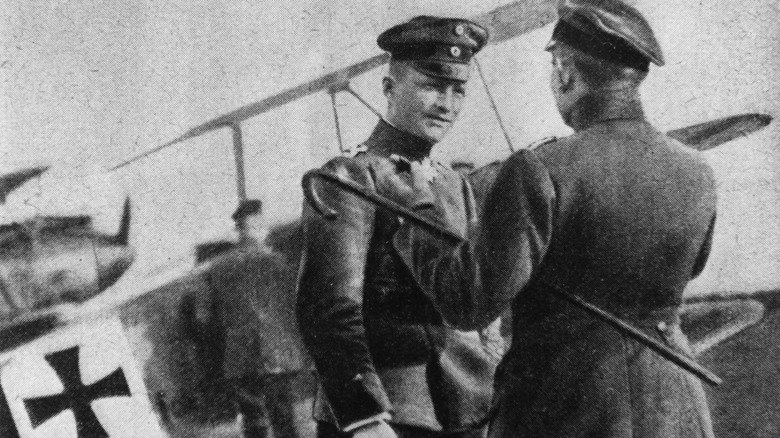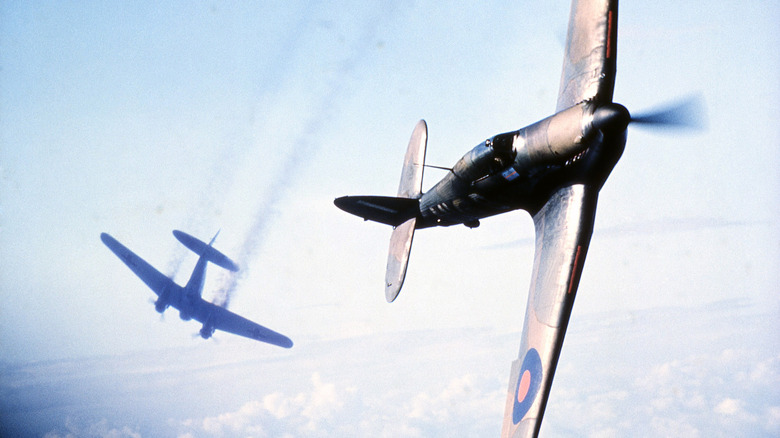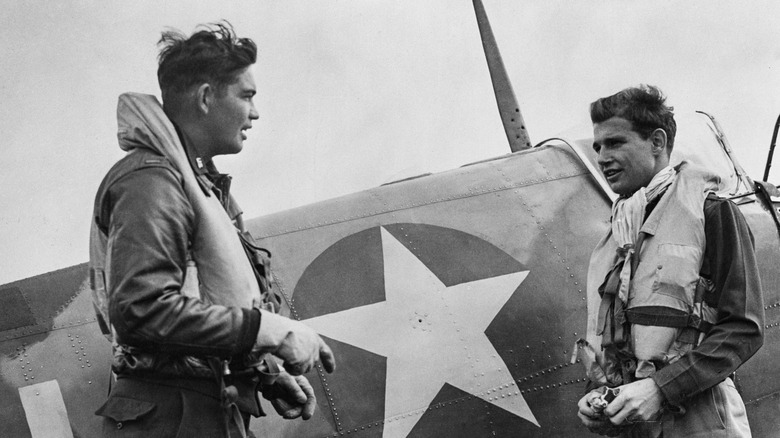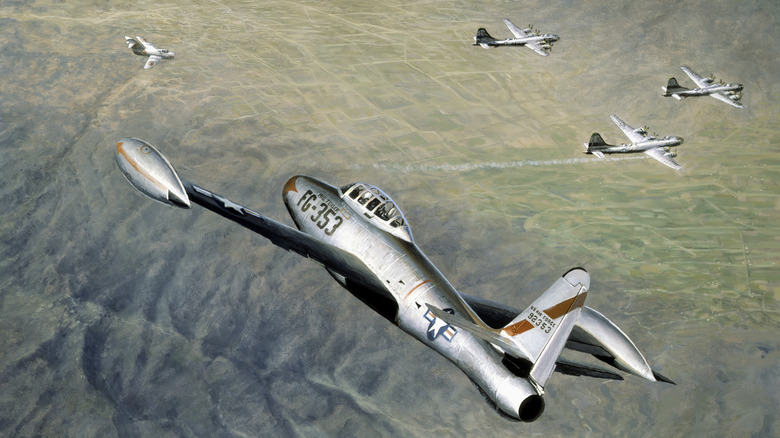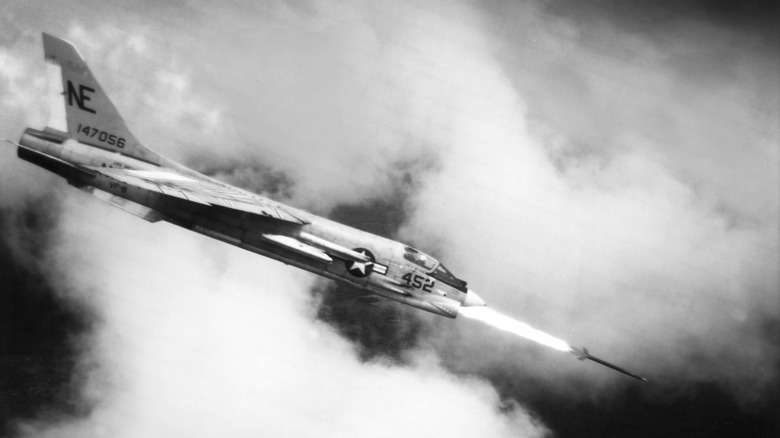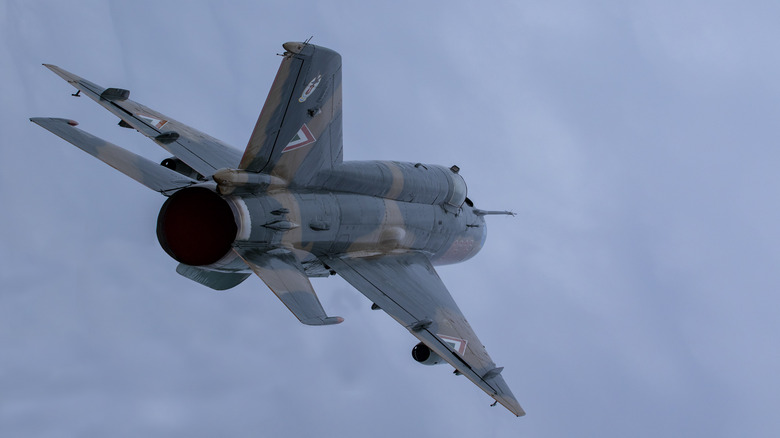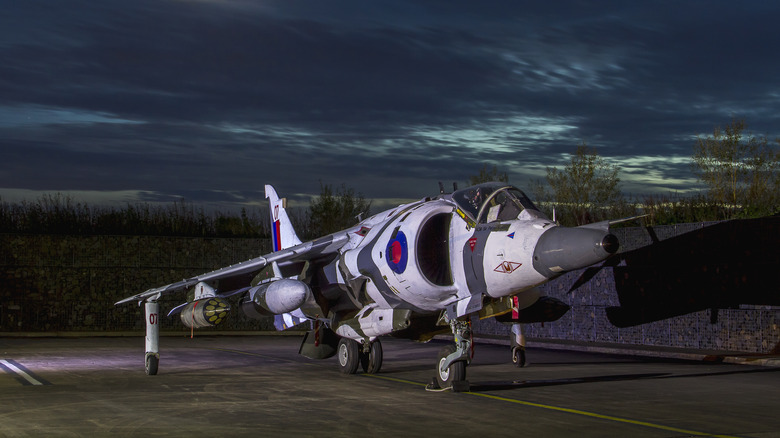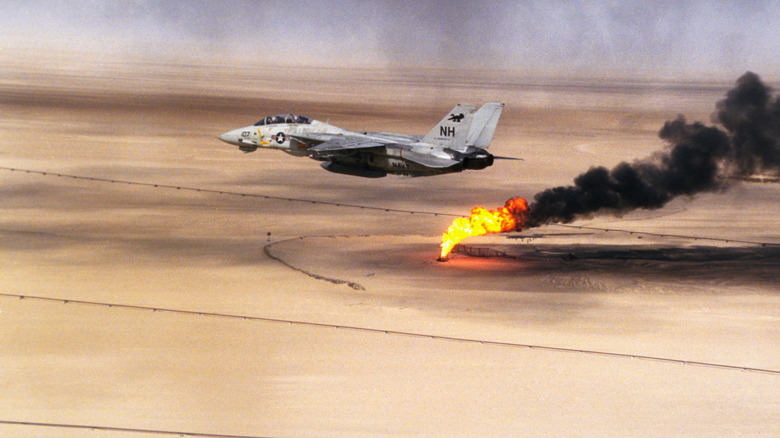8 Of The Most Intense Dogfights In Aerial Combat History
Aerial combat engagements between fighter aircraft, or dogfights, have occurred throughout aviation history. From the battling aces of World War I to the mechanized warbirds of World War II, control over the skies was often crucial to securing success on the ground. Jet-propelled mavericks during the Korean War preceded the development of aerial combat tactics over Vietnam, with wars in Asia and the Middle East incorporating the highly technical machines we know today.
It's tough to imagine the steely nerve it must take for a fighter pilot to face off against their foe thousands of feet above sea level. In the early days of dogfights, when crewed flight was in its infancy, World War I flying aces had a life expectancy of just a few weeks. Even today, with advanced warning systems, better evasive abilities, and countermeasures that can be deployed, advanced weaponry makes aerial combat just as daunting a prospect. Pilots spend countless hours honing their skills, both in simulators and practical training, and only the elite qualify as mentally and physically prepared for battle in the skies.
Here, we pay tribute to some of the fiercest dogfights ever recorded throughout aerial warfare's history. These battles were fought by the most daring pilots ever to have lived and died for their country. These group battles and one-to-one air engagements were chosen for their intensity while considering pilot skill, aircraft capabilities, tactics, and the impact on their war's outcome.
The Red Baron and Lanoe Hawker
By 1916, World War I had been in full swing for two years, and some pilots of the Luftstreitskräfte and Royal Flying Corps (precursors of the World War II Luftwaffe and Royal Air Force) had accrued many flying hours. Two of these were the German aristocrat Manfred Von Richthofen and the Englishman Lanoe Hawker. Each had repeatedly proven their value in the skies over northern France.
Von Richthofen had gained numerous aerial victories in some of the first dogfights ever fought, earning the nickname "Red Baron." Major Hawker was not as celebrated and flamboyant, but he was nonetheless successful as the 25-year-old commander of the RFC's No. 24 Squadron. The two finally met following the infamous Battle of the Somme, one of the bloodiest in history, seeking to control the skies above the war-ravaged trenches. Von Richthofen later noted that it was very apparent that his adversary was no amateur, as the Red Baron pursued Major Lanoe Hawker in his bright red Albatross D.II.
The Red Baron's plane was superior to the de Havilland D.H.2 flown by Hawker, but he put up a valiant fight, performing many evasive maneuvers to keep his foe at bay. The two circled in combat, descending from 5,000 feet to 300 feet, as Hawker unleashed almost all of his 1,000 rounds of ammunition before one of the Red Baron's bullets struck Hawker in the head. He crashed behind enemy lines, and the Germans buried him beside his plane.
The Battle of Britain
By 1940, the invasion of Great Britain was inevitable. Having been pushed back from the European Theater at Dunkirk, Germany was poised to attack from the air. Remarkably, having been banned from having an air force in the Treaty of Versailles in the aftermath of World War I, Germany had amassed the most powerful air force, Hermann Goring's fearsome Luftwaffe, by the time it made its move.
The Luftwaffe began its campaign in earnest on August 13th, 1940, and soon, the island nation was under regular bombardment from German Heinkel He 111 bombers, supported by the agile Messerschmitt Bf 109 and Bf 110 fighters. These were pitted against Hawker Hurricane and Supermarine Spitfire fighter planes of Great Britain in a constant struggle to defend its borders.
Great Britain was highly organized but often outclassed and outnumbered by the Germans. As many as 3,000 personnel fought in the battle, the entirety of the RAF forces, organized into tight units that each defended a portion of the country. This solid defense, coupled with Germany's constant resupply issues, put the enemy on the back foot. The Allies also had a robust support system of nations to call for aid, and New Zealander, South African, Polish, and Czech squadrons joined in the fight. Ultimately, the Luftwaffe suffered a defeat over England from which it never fully recovered. Winston Churchill paid tribute to the airmen, saying, "Never was so much owed by so many to so few" as the tide of World War II started to turn in the Allies' favor.
The Dieppe Raid
August 19, 1942, marked the first large-scale assault on Nazi-occupied France since the Allies' humiliating defeat at Dunkirk. Operation Jubilee was on a much smaller scale than D-Day (Operation Overlord) two years later and was more of an experimental exercise to test amphibious operations, distract the Germans from the Eastern Front, and check the efficacy of Germany's communications. 6,000 Allied troops descended on the coast around the town of Dieppe, including British and Canadians, and a detachment of U.S. Rangers. These were supported by 1,000 British and Canadian planes that met considerable resistance from an enemy that fully expected the attack.
The Dieppe Raid was World War II's largest dogfight between the Allies and Germany. Germany was vastly outnumbered, with around 120 fighter planes, 100 bombers, and ground support from anti-aircraft batteries. As the battle raged on the beaches below, mayhem reigned in the skies as bombs rained down on strategic positions and fighters weaved between enemy flak while dogfighting with German forces. While the Germans suffered the loss of 48 planes, the Allies lost 106 by the time the battle was over. The result on the ground was even worse, with over half the Allied forces killed, captured, or wounded. The Canadian troops, in particular, suffered many casualties in what was one of the country's worst days of World War II.
While valuable lessons were learned during the Dieppe Raid that were later applied to successful amphibious invasions in Italy and on D-Day, there was no denying that Germany outclassed the Allies in Operation Jubilee. The Luftwaffe was restored to combat readiness within hours of the victory while the Allies licked their wounds, and it would be almost two years before they made their next big move on the continent.
The Korean War
It's difficult to determine just how vital a role each combatant's air forces played during the Korean War, as North Korean resources are unavailable for analysis. We do know that the conflict witnessed intense aerial combat between American and United Nations forces against Soviet-backed North Korean and Chinese forces in some of the earliest fighting that showcased jet fighters.
During the Korean Campaign, UN forces flew around 700,000 sorties against the Communist forces, who flew around 90,000. Most North Korean sorties were concentrated northwest of the peninsula's border with South Korea, dubbed MiG Alley, as it was heavily patrolled and the scene of most dogfights. These were coordinated from the several North Korean bases nearby, allowing for longer flying times due to their proximity to the combat zone, and the fighter aircraft were backed by air defenses on the ground.
The first ever jet-on-jet dogfight was flown over North Korea when Lieutenant Russel Brown downed a MiG-15 near China. Communist forces were relatively inexperienced compared to their UN (primarily American) counterparts, and the Japan-based U.S. aircraft regularly scored kills in dogfights in their superior fighter jets. These included the F-86 Sabre, which proved a worthy adversary to the Soviet MiG-15 and was comparable, with its swept wing profile and speed of over 600 miles per hour. The skies over North Korea proved to be a testing ground for new technologies in the emerging Cold War, as, for the next four decades, East and West would be embroiled in geopolitical tension. However, this came at a considerable cost, as 2,714 aircraft were destroyed, and 4,055 flight personnel lost their lives in the U.N. forces alone, with no available figures for their Communist opponents.
The Vietnam War
Just over a decade after the war in Korea, American air forces were once again back in Asia fighting Communists in Vietnam. This era of warfare saw intense dogfights involving American aircraft, such as the F-4 Phantom and F-8 Crusader, pitted against North Vietnamese MiG-21 fighters in what came to be known as the first modern air war. In yet another north-versus-south conflict, the Vietnamese People's Air Force was initially using inferior MiG-17s, were outnumbered, and were not as well-trained in aerial combat as their U.S. counterparts. However, intense fighting dominated the skies over the drawn-out duration of the war, and the Viet Kong made up for its shortcomings with tenacity and fearlessness in defending their country. It also had more reliable missiles and better ground support, as they were nearer the combat zone and had the option of retreating to Chinese airspace in emergencies.
During the long aerial bombardment between 1965 and 1968, known as Operation Rolling Thunder, the VPAF would act on ground intelligence before engaging in single-pass maneuvers to limit time in the air. However, after Operation Linebacker in 1972, dogfights were not uncommon once the VPAF upgraded to supersonic MiG-21s.
While fighting was intense during the short period of dogfighting over North Vietnam, only two pilots were credited as being United States fighter aces in this period. These were Richard Ritchie and Randy Cunningham, who each made the required five confirmed kills to be called an ace. By the time the conflict was over, the United States Air Force had lost 70 planes in total, whereas the Vietnamese People's Air Force lost more than double that amount.
The Yom Kippur War
Many aerial engagements during the Yom Kippur War of 1973 involved intense dogfights between Israelis and a coalition of Arab air forces from Syria and Egypt. The latter also included squadrons from Libya, Iraq, Algeria, and North Korea, who flew Soviet-supplied Mig-21s. The Arab coalition forces tried to take advantage of the Jewish Holiday of Yom Kippur to catch the Israeli army by surprise.
One engagement was a particularly intense example of dogfighting. Here, two pairs of Israeli Kurnass fighters were deployed over Suez to patrol the area as part of a special operation. Flying low over Egypt to identify targets, they soon came across two North Korean MiGs on their radars. Immediately, the enemy tried to draw them into a fight. Two of the Kurnass fighters fired AAM missiles simultaneously. In the poor desert visibility, the plane to the rear nearly decimated his ally, but luckily, the rockets hit the intended target, which erupted in a fireball before losing altitude and crashing to the earth. At the same time, a surface-to-air missile struck the other MiG in a coordinated effort that wiped out both enemy targets.
Ultimately, Israel triumphed in this short but bloody war. Syria lost more of the Golan Heights to Israel, having already ceded much of it in the 1967 Six-Day War, but Israel agreed to return the Sinai peninsula to Egypt. The war led to a realization that Israel's neighbors were a force to be reckoned with, and this resulted in the signing of a peace treaty between Israel and Egypt as a positive outcome.
The Falklands War
The Falkland Islands, or Malvinas, are still a hotly-contested British colony. However, in 1981, it only took a band of Argentine scrap metal merchants to plant a flag on the nearby protectorate of South Georgia for this delicate situation to escalate into what we now know as the Falklands War. [NOTE: The actual official "Falklands War" began in earnest in 1982.] Before long, a flotilla of British ships was en route to the islands to engage with Argentina, among them aircraft carriers loaded with helicopters, Avro Vulcan bombers, and Harrier Jump Jet fighters with vertical takeoff and landing capabilities.
While British and Argentine forces encountered close combat on the ground, intense aerial combat ensued, with notable dogfights involving the Harrier Jump Jet and Argentina's Mirage III, Dagger, and Skyhawk aircraft. The Harriers, armed with sidewinder air-to-air missiles, were more than capable of winning the war in the air.
On one particularly brutal day of dogfights, Argentinian Dagger and Skyhawk aircraft attacked several British positions and vessels, destroying the British ships Ardent and Argonaut. The Harrier jets rained fire on them, downing five Argentinian Daggers, five Skyhawks, and two Pucara turboprop aircraft, with the British losing one plane and two helicopters. The outgunned Argentinians put up a valiant fight throughout the Falklands War, but the British were incessant, flying over 1,500 sorties to hammer the enemy repeatedly. After 74 days, Argentina surrendered, having lost 649 soldiers in battle. The U.K., by comparison, lost 255 personnel.
The Gulf War
There have been few dogfights in aerial combat ever since the first Gulf War, largely due to the United States air superiority in that conflict. In 1991, U.S. and coalition forces faced off against the Iraqi Air Force with an air campaign that included intense dogfights and missile engagements, during which Saddam Hussein's forces lost a total of 33 fighter jets, whereas the U.S. lost a single F-18 Hornet.
In the second phase of the Gulf War, during Operation Desert Storm, U.S. forces flew 65,000 sorties against the enemy. Most of these were engaged in ground attack missions, but occasionally, they would meet an enemy challenger in the air. Pilots could easily switch between air-to-ground duties and air-to-air combat. In one case, a U.S. pilot downed an enemy MiG 21 before carrying on with a bombing mission, in what was the first example of a MiG being shot down by a Navy aviator since the Vietnam War.
The way that wars are waged in the air has changed. During the Vietnam War era, the majority of air-to-air kills were due to cannon fire, whereas in the modern age, these have been replaced by various missiles. Situational awareness has also greatly improved with the use of satellite positioning and modern avionics. As a result, aging fighter jets pose a much lower threat to wealthier nations with modern weaponry.
